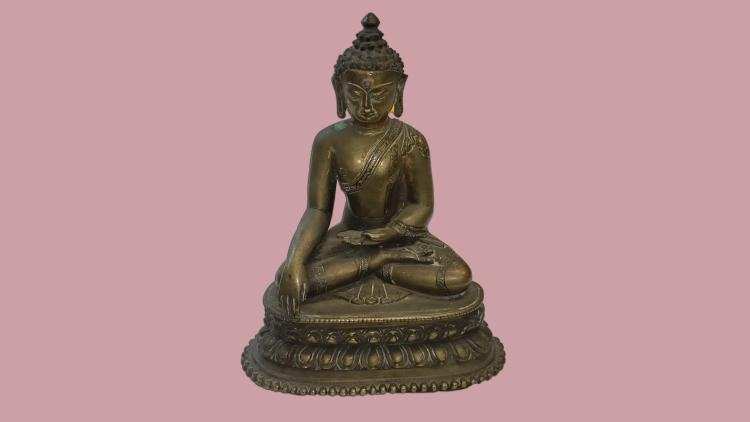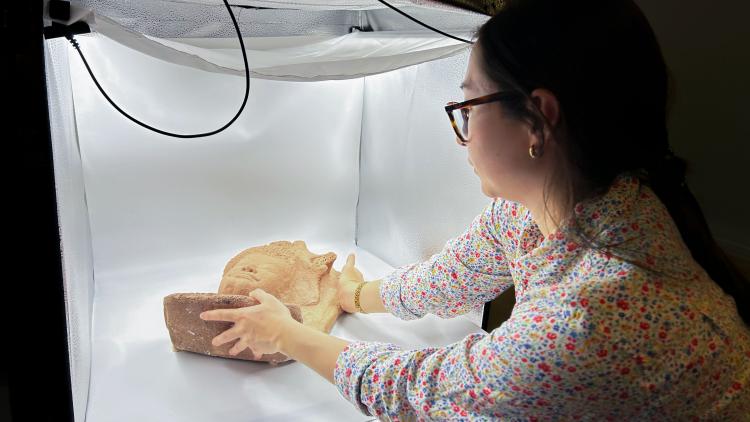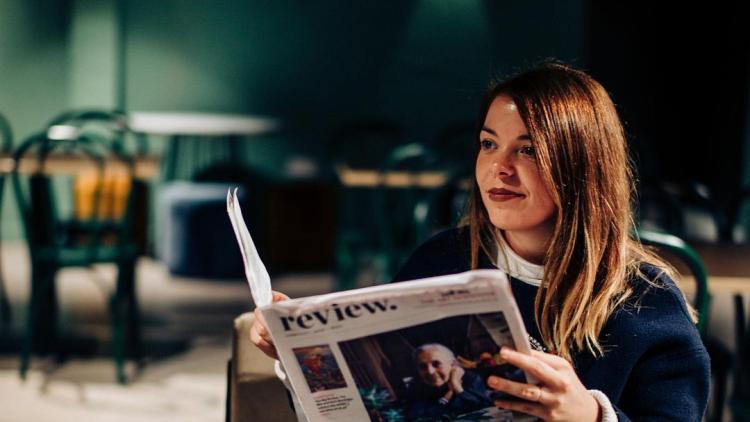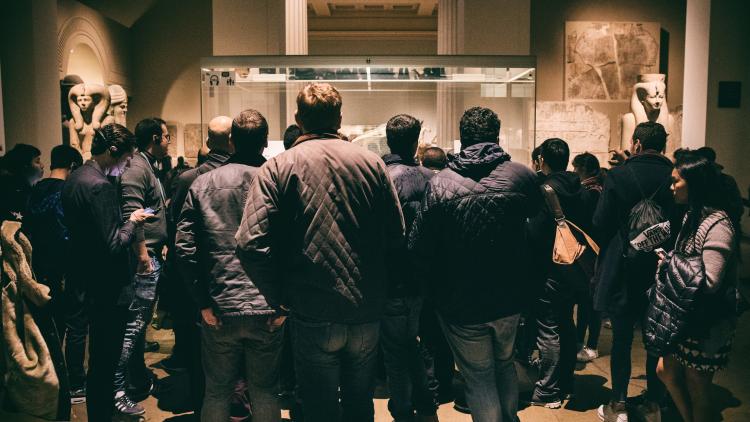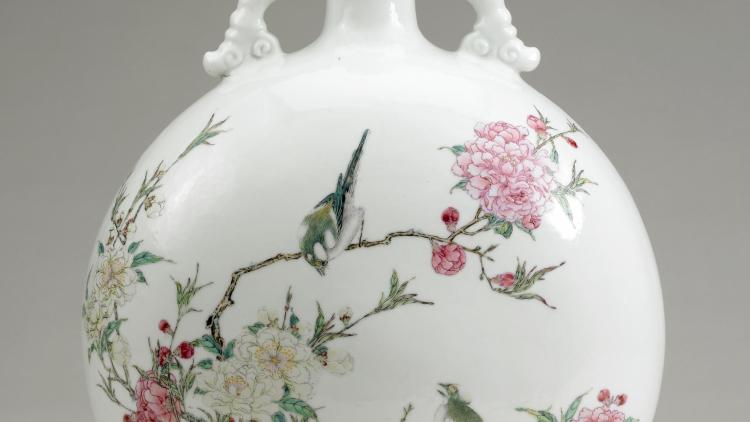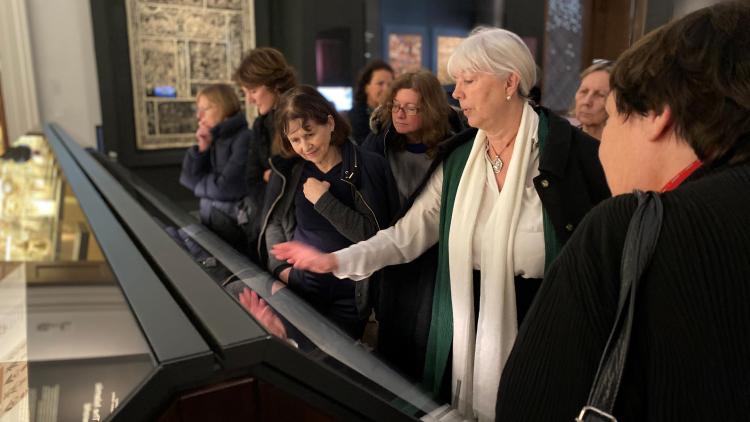BA History of Art (Asia, Africa and Europe)


Key information
- Duration
- 3 years
- Start of programme
- September
- Attendance mode
- Full-time
- Location
- Russell Square, College Buildings
- Fees
-
Home student fees: £9,250
Overseas student fees: £21,990Please note that fees go up each year.
See undergraduate fees for further details. - Course code
- V351 BA/HArAAE
- Entry requirements
-
A Levels: AAB
Contextualised offer: ABB
-
Austria: Reifeprufungszeugnis / Maturazeugnis: four subjects at 1, 1, 2, 2
A Level equivalent: AAB
Contextualised offer: ABB -
Belgium: Diploma van Secundair Onderwijs: 80% (8/10, 16/20) overall
A Level equivalent: AAB
Contextualised offer: ABBInformation for prospective students from Belgium
-
Bulgaria: Diploma za Zavarsheno Sredno Obrazovanie: 5.5 and 5.0 in two State Maturity Exams
A Level equivalent: AAB
Contextualised offer: ABB -
Canada: High School Diploma: 83% with 5 acceptable Grade 12 subjects (most territories).
British Colombia: AAABB in Grade 12 subjects.A Level equivalent: AAB
Contextualised offer: ABBInformation for prospective students from Canada
-
China: Senior Secondary Graduation Certificate + Gaokao: 80% overall in Gaokao PLUS 85% overall in Senior Secondary School Graduation Certificate (year 11 and 12)
A Level equivalent: AAB
Contextualised offer: ABBInformation for prospective students from China
-
Croatia: Matura Certificate: 5 overall with 5 in 2 Higher level subjects
A Level equivalent: AAB
Contextualised offer: ABB -
Cyprus: Apolytirion with 2 A-Levels: Apolytirion 18/20 + A-level grades AB
A Level equivalent: AAB
Contextualised offer: ABB -
Czech Republic: Matura Certificate: 1, 1, 2, 2
A Level equivalent: AAB
Contextualised offer: ABB -
Denmark: Studentereksamen; Hojere Forberedelseseksamen; Hojere Handelseksamen; Hojere Teknisk Eksamen: 10 plus 10, 10, 7 in three Level A subjects
A Level equivalent: AAB
Contextualised offer: ABBInformation for prospective students from Denmark
-
Estonia: Gümnaasiumi lõputunnistus with the Riigieksamitunnistus: 4.5 with 85%, 85%, and 80% in 3 state exams
A Level equivalent: AAB
Contextualised offer: ABB -
Finland: Ylioppilastukint / Studentexamen: four subjects at 6, 6, 6, 5
A Level equivalent: AAB
Contextualised offer: ABB -
France: French Baccalaureat or Option Internationale du Baccalauréat (OIB): 14/20
A Level equivalent: AAB
Contextualised offer: ABBInformation for prospective students from France
-
Germany: Abitur: 1.6
A Level equivalent: AAB
Contextualised offer: ABBInformation for prospective students from Germany
-
Greece: Apolytirion of Geniko Lykeio with Pan Hellenic exams: 18.5/20
A Level equivalent: AAB
Contextualised offer: ABBInformation for prospective students from Greece
-
Hong Kong: Hong Kong Diploma of Secondary Education: 554 in two electives and one core module (all other subjects grade 3)
A Level equivalent: AAB
Contextualised offer: ABBInformation for prospective students from Hong Kong
-
Hungary: Matura (Erettségi): 5 overall
A Level equivalent: AAB
Contextualised offer: ABB -
Iceland: Stúdentspróf: 8
A Level equivalent: AAB
Contextualised offer: ABB -
India: Standard XII: 80% (CBSE, CISCE, Tamil Nadu, Maharashtra & West Bengal boards), 85% (all other state boards)
A Level equivalent: AAB
Contextualised offer: ABBInformation for prospective students from India
-
Ireland: Irish Leaving Certificate: H1, H1, H2, H2, H3
A Level equivalent: AAB
Contextualised offer: ABB -
Israel: Bagrut: Overall grade of 8-10, 85% with 3 subjects at 5-unit level
A Level equivalent: AAB
Contextualised offer: ABBInformation for prospective students from Israel
-
Italy: Diploma Consequito con L’Esame di Stato: 85% overall
A Level equivalent: AAB
Contextualised offer: ABBInformation for prospective students from Italy
-
Latvia: Certificate of General Secondary Education: 88% in four State subject exams
A Level equivalent: AAB
Contextualised offer: ABB -
Lithuania: Brandos Atestatas: 9/10 and 90%, 90%, 85% in three State Exams
A Level equivalent: AAB
Contextualised offer: ABBInformation for prospective students from Lithuania
-
Malta: Advanced Matriculation Certificate: AA (Advanced) + BBB (Intermediate)
A Level equivalent: AAB
Contextualised offer: ABB -
Netherlands: Voorbereidend Wetenschappelijk Onderwijs: Overall 7.5 with 8, 8, 8, 7 in four subjects
A Level equivalent: AAB
Contextualised offer: ABB -
Norway: Vitnemål vidergaende opplaering: 4.7 overall
A Level equivalent: AAB
Contextualised offer: ABBInformation for prospective students from Norway
-
Poland: New Polish Matura: 80% in three Advanced Level subjects
A Level equivalent: AAB
Contextualised offer: ABBInformation for prospective students from Poland
-
Portugal: Diploma de Ensino Secundario: overall 18/20
A Level equivalent: AAB
Contextualised offer: ABB -
Romania: Diploma de Bacalaureat: 9 overall
A Level equivalent: AAB
Contextualised offer: ABBInformation for prospective students from Romania
-
Singapore: Polytechnic Diploma (Nanyang, Ngee Ann, Singapore, Temasek and Republic Polytechnic): GPA 3.5
A Level equivalent: AAB
Contextualised offer: ABBInformation for prospective students from Singapore
-
Slovakia: Maturitná skúška / Maturita / Vysvedčenie o maturitnej skúške: four subjects at 1, 1, 2, 2
A Level equivalent: AAB
Contextualised offer: ABB -
South Africa: National Senior Certificate: 77766
A Level equivalent: AAB
Contextualised offer: ABBInformation for prospective students from South Africa
-
Spain: Curso de Orientación Universitaria / Título de Bachillerato: 8
A Level equivalent: AAB
Contextualised offer: ABBInformation for prospective students from Spain
-
Sweden: Slutbetyg / Examensbevis från Gymnasieskolan: A in 1500 credits and no grades below D / 18.5 / mainly A overall (MVG/VG)
A Level equivalent: AAB
Contextualised offer: ABB -
Switzerland: Federal Maturity Certificate: 4.7
A Level equivalent: AAB
Contextualised offer: ABB -
Tanzania: Advanced Certificate of Secondary Education: ACSE with AAB in 3 principle subjects
A Level equivalent: AAB
Contextualised offer: ABB -
Trinidad and Tobago: CAPE: Six CAPE units with grade 2 (+two double-unit courses = grade 2)
A Level equivalent: AAB
Contextualised offer: ABB -
Turkey: Lise Diplomasi: 80-85% (depending on high school)
A Level equivalent: AAB
Contextualised offer: ABB -
USA: High School Diploma plus ACT, SAT, or AP exams:
- High School Diploma GPA 3.2 plus SAT 1300 or ACT 29 and 2 AP's at 5,4/ 3 AP's at 5,4,4
or - High School Diploma GPA of 3.4 plus 2 AP's at 5,4 or 3 AP's at 5,4,4
or - High School Diploma GPA of 3.5 plus SAT 1340 or ACT 30
or - 2-year Associate degree GPA 3.2
A Level equivalent: AAB
Contextualised offer: ABB - High School Diploma GPA 3.2 plus SAT 1300 or ACT 29 and 2 AP's at 5,4/ 3 AP's at 5,4,4
-
See undergraduate entry requirements and English language requirements for international and alternative entry requirements.
Course overview
The BA History of Art (Asia, Africa and Europe) is unrivalled in evenly combining the specialist study of Asian and African art history with the specialist study of European art history. It is taught jointly by the Department of the History of Art and Archaeology at SOAS and the History of Art department at UCL
Students select courses from each institution. They receive theoretical and methodological training, which is combined with the study of particular regions, themes and critical issues.
The History of Art and Archaeology department at SOAS contains some of the world’s leading experts in Asian and African art history and archaeology, whose ground-breaking research informs and is informed by their teaching.
Why study History of Art (Asia, Africa and Europe) at SOAS?
- We are ranked 15th in the UK for Arts and Humanities (QS World University Rankings 2023)
- 100% overall student satisfaction (NSS 2022)
- we partner with the British Council to offer a School of Arts student one fully funded residency at the annual Venice Architecture Biennale
- our graduates work in arts, culture and heritage roles, including in galleries, museums, archives, conservation, publishing and arts administration.
- the large portfolio of transferable skills you will acquire enables you to forge a career in a range of other fields across the world. Many graduates decide to pursue postgraduate study in the History of Art and Archaeology or a related discipline.
Structure
In each year, students take modules at UCL to the value of 60 credits and 60 credits of modules in the department of History of Art and Archaeology. Thus they bring together the study of European, Asian and African Art in a flexible manner unique within the British University system.
The modules in the UCL part of this degree include , in the first year, general modules which survey the history of art and introduce students to a range of the intellectual, observational and professional skills demanded of the art historian. In the second year, students work on more focused study of aspects of the history of western art since c.1200, and take at least one module concerned with the development of the western idea of art and current approaches to art history, or with the history of the methods and materials of artists. In the third year, students take a Special Subject (a module which treats a theme or career in detail), and may do another special subject and/or an Undergraduate Report (similar to a SOAS Independent Study Project).
Anyone requiring further information on the UCL part of this course should contact Mr Robert Brown at University College London (address: Gower Street, London WC1E 6BT, phone: (0)20 3108 4012, emaill r.brown@ucl.ac.uk
Important notice
The information on the website reflects the intended programme structure against the given academic session. The modules are indicative options of the content students can expect and are/have been previously taught as part of these programmes. However, this information is published a long time in advance of enrolment and module content and availability is subject to change.
Year 1
Compulsory modules
Students will take the following 4 compulsory modules at SOAS
And
Students will take the following core module at UCL:
- HART0001 - History of Art and its objects - 30 credits - FHEQ Level 4
And
Students will take the following compulsory modules at UCL:
- HART0005 - First-Year History of Art Survey (2): c.1600 to the Contemporary - 15 credits - FHEQ Level 4
- HART0006 - First-Year History of Art Survey (1): Premodernity to c.1600 - 15 credits - FHEQ Level 4
Year 2
Compulsory modules
Students will take the following 2 compulsory modules at SOAS
And
Students will take the following 2 compulsory modules at UCL:
- HART0035 - Advanced Lecture in the History of Art (post 1800) - 15 Credits - FHEQ Level 5
- HART0036 - Advanced Lecture in the History of Art (before 1800) - 15 Credits - FHEQ Level 5
And
Students take modules at SOAS to the value of 30 credits from either list A or list B.
And
Students will take modules to the value of 30 credits of any of the following combinations:
- 15 credits of modules at UCL from a list of UCL Methods modules (these modules can also be taken in year 3) and 15 credits of modules at UCL from a list of UCL History of Art options
- 30 credits of modules at UCL from a list of UCL History of Art options
Year 3 - SOAS-based project
Compulsory module
Students will take the following compulsory module at SOAS
And
Students take modules at SOAS to the value of 30 credits from either list A or list B.
And
Students will take modules to the value of 60 credits of any of the following combinations:
- 60 credits of modules at UCL from a list of UCL Special Subject modules.
- 30 credits of modules at UCL from a list of UCL Special Subject modules, 15 credits of modules at UCL from a list of UCL Methods modules (if not completed in Year 2) and the 15-credit module at UCL: Independent Study Essay in History of Art (HART0119).
Year 3 - UCL-based project
Students will take the following module at UCL:
- Undergraduate Report - HART0118 - 30 credits - FHEQ level 6
And
Students take modules at UCL to the value of 30 credits from a list of UCL special subject modules
And
Students take modules at SOAS to the value of 60 credits from either list A or list B.
Guided options
List A and list B will be offered in alternating years.
List A
List B
Teaching and learning
All first year modules involve a weekly lecture and tutorial. In the second and third year, where student numbers may be lower, a seminar may replace the lecture.
For most modules, assessment involves coursework and an unseen examination. In the 1st year, coursework entails short, concentrated pieces of work. In the 2nd and 3rd years, coursework emphasis shifts to longer papers.
In the final year, students are required to complete an Independent Study Project on a subject of their choice, and are also encouraged to undertake projects, supervised by members of staff, in the form of an essay-based advanced study.
Contact hours
All full-time undergraduate programmes consist of 120 credits per year, in modules of 30 or 15 credits. They are taught over 10 or 20 weeks. The programme structure shows which modules are compulsory and which optional.
As a rough guide, 1 credit equals approximately 10 hours of work. Most of this will be independent study. It will also include class time, which may include lectures, seminars and other classes. Some subjects, such as learning a language, have more class time than others. In the School of Arts, most undergraduate modules have a one- or two-hour lecture or seminar every week. Some, but not all, also have a 1-hour seminar or tutorial every week.
SOAS Library
SOAS Library is one of the world's most important academic libraries for the study of Africa, Asia and the Middle East, attracting scholars from all over the world. The Library houses over 1.2 million volumes, together with significant archival holdings, special collections and a growing network of electronic resources.
Fees and funding
Fees for 2023/24 entrants per academic year
| Programme | Full-time | |
|---|---|---|
| Home students | Overseas students | |
|
BA, BSc, LLB |
£9,250 |
£21,160 |
| BA/BSc Language year abroad | £1,385 | £10,580 |
Please note that fees go up each year.
See undergraduate fees for further details.
Employment
Students in the School of Arts develop a critical and theoretically informed approach to global arts and culture. In addition to an intercultural awareness and practical expertise, graduates gain a wide portfolio of transferable skills which are especially sought after in the creative and cultural industries.
Recent graduates have been hired by:
- Christie’s
- Christine Park Gallery
- Crisis
- Design Museum
- Hong Kong Museum Of Art
- India Foundation For The Arts
- Japanese Gallery
- Museum of East Asian Art
- Music in Detention
- National Gallery
- Pan Arts
- People Projects Culture & Change
- Roundhouse Trust
- Somerset House Trust
- Songlines Magazine
- Sotheby's
- South Asian Art UK
- Stratford Circus Arts Centre
- Taiwan Embassy
- The Alliance for Global Education
- The British Embassy
- The National Museum Of Korea
- The Royal Collection
- Victoria and Albert Museum
Find out about our Careers Service.

